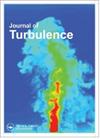具有前缘缺陷的翼型流动的大涡模拟
IF 1.6
4区 工程技术
Q3 MECHANICS
引用次数: 1
摘要
摘要:我们对机翼上的气流进行了大涡模拟,以了解设计用于模拟积冰的前缘粗糙度的影响。粗糙度元素突出到边界层之外,边界层在前缘附近非常薄;因此,该配置并不代表经典的粗糙壁边界层,而是宏观障碍物上的流动。进行了网格收敛性研究,并通过与文献中的数值和实验研究进行比较来验证结果。障碍物的主要作用是加速向湍流的过渡。对于不同的粗糙度形状,观察到结构生成的显著变化。不规则性的三维性对流动有着强烈的影响:它产生了高速(“波峰”)和低速(“波谷”)区域的交替区域,这种现象被称为“通道化”。山谷区域类似于减速边界层:它们表现出相当大的尾流和更高水平的雷诺应力。另一方面,峰值区域更类似于加速区域。讨论了通道现象对湍流模型的影响。本文章由计算机程序翻译,如有差异,请以英文原文为准。
Large-eddy simulations of the flow on an aerofoil with leading-edge imperfections
ABSTRACT We performed large-eddy simulations of the flow over an aerofoil to understand the effects of leading-edge roughness designed to mimic ice accretion. The roughness elements protrude outside the boundary layer, which, near the leading edge, is very thin; thus, the configuration does not represent a classical rough-wall boundary layer, but rather the flow over macroscopic obstacles. A grid convergence study is conducted and results are validated by comparison to numerical and experimental studies in the literature. The main effect of the obstacles is to accelerate transition to turbulence. Significant variations in structure generation are observed for different roughness shapes. The three-dimensionality of the irregularities has a strong impact on the flow: it creates alternating regions of high-speed (‘peaks’) and low-speed (‘valleys’) regions, a phenomenon termed ‘channelling’. The valley regions resemble a decelerating boundary layer: they exhibit considerable wake and higher levels of Reynolds stresses. The peak regions, on the other hand, are more similar to an accelerating one. Implications of the channelling phenomenon on turbulence modelling are discussed.
求助全文
通过发布文献求助,成功后即可免费获取论文全文。
去求助
来源期刊

Journal of Turbulence
物理-力学
CiteScore
3.90
自引率
5.30%
发文量
23
审稿时长
6-12 weeks
期刊介绍:
Turbulence is a physical phenomenon occurring in most fluid flows, and is a major research topic at the cutting edge of science and technology. Journal of Turbulence ( JoT) is a digital forum for disseminating new theoretical, numerical and experimental knowledge aimed at understanding, predicting and controlling fluid turbulence.
JoT provides a common venue for communicating advances of fundamental and applied character across the many disciplines in which turbulence plays a vital role. Examples include turbulence arising in engineering fluid dynamics (aerodynamics and hydrodynamics, particulate and multi-phase flows, acoustics, hydraulics, combustion, aeroelasticity, transitional flows, turbo-machinery, heat transfer), geophysical fluid dynamics (environmental flows, oceanography, meteorology), in physics (magnetohydrodynamics and fusion, astrophysics, cryogenic and quantum fluids), and mathematics (turbulence from PDE’s, model systems). The multimedia capabilities offered by this electronic journal (including free colour images and video movies), provide a unique opportunity for disseminating turbulence research in visually impressive ways.
 求助内容:
求助内容: 应助结果提醒方式:
应助结果提醒方式:


